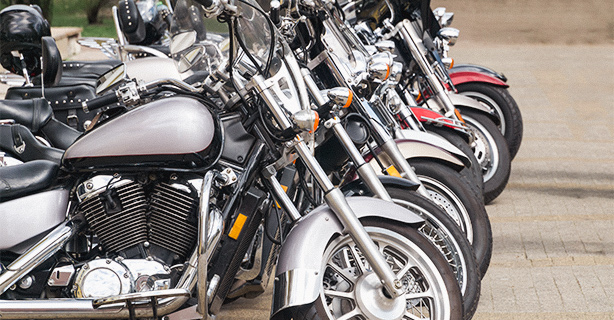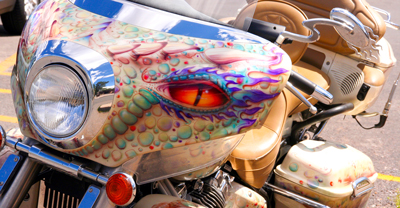How to buy a motorcycle: A complete guide for beginner and experienced riders


0 min. read
There’s nothing quite like the freedom of the open road on two wheels. But choosing the right motorcycle for you can be challenging. Whether you're a first-time buyer or ready to upgrade your current ride, this guide can help you feel ready and informed when it's time to make that purchase.

Get a free motorcycle insurance quote today.
Understanding your motorcycle options
Before buying your first motorcycle, research and understand what type of motorcycle suits your riding style and experience level. Different styles offer different strengths—some built for long-haul comfort, others for high-speed thrills or everyday versatility.
Types of motorcycles
Standard

These bikes keep you sitting upright, which means less back and wrist pain on longer rides. They're ideal for relaxed riding and include iconic brands like Harley-Davidson®. Many riders choose these as their first bike.
Cruiser

Cruisers are all about classic style with their low seat heights, forward-mounted foot pegs, and pulled-back handlebars. Their accessibility and low seat height make them ideal for relaxed riding and new riders.
Sportbike

For the speed demons among us, sportbikes deliver adrenaline on demand. They’re not beginner-friendly, and they’ll give your core muscles a workout, but nothing beats the thrill of leaning into corners on one of these machines.
Touring

Touring bikes are like motorcycle RVs—built for crossing multiple states, not just local rides. They come with windshields, fairings, and plenty of storage, so you can bring everything you need for long-distance adventures.
Dual-sport/Adventure

These versatile machines handle both paved roads and off-road riding, making them perfect for explorers who don’t want to be limited by terrain.
New vs. used: Which is right for you?
One of the biggest decisions many riders make is whether to buy new or used. Here’s what to keep in mind:
Warranty protection: New bikes typically come with manufacturer warranties covering defects and certain repairs.
Latest features: Brand-new bikes come with all the bells and whistles, like better safety tech, improved gas mileage, and top-tier performance.
No hidden problems: New motorcycles come without potential undisclosed issues from previous owners.
Financing options: Motorcycle dealerships frequently offer attractive financing packages, even for those with less-than-perfect credit, often making it easier to afford a higher-priced new motorcycle.
Why consider a used motorcycle
When shopping for your next bike, the used market offers several compelling advantages that might make more sense for your situation and budget. Here are some reasons many experienced riders opt for pre-owned machines:
Save money upfront and potentially long-term
Used motorcycles typically cost 20–30% less than comparable new models. And depending on factors like the bike’s replacement value and repair costs, insurance rates may be lower for older models than newer ones.
Skip the depreciation hit
New motorcycles can drop in value the moment you ride off the lot. When you buy used, that initial depreciation has already happened—potentially saving you money if you sell or trade the bike later on.
Get more bike for your budget
Your set price point might get you a basic new motorcycle—or a higher end used model with upgraded features and performance. Many riders find the used market opens doors to bikes that might otherwise be out of reach.
Setting your motorcycle budget
Buying a motorcycle isn’t just about the sticker price. To avoid financial surprises down the road, it’s helpful to think in terms of the whole package of what owning a bike really costs. Here are some costs to consider:
Insurance
Rates vary based on age, location, riding history, and bike type. Shop around for quotes before making a decision. Rates can differ by hundreds of dollars between companies for the same coverage.
Maintenance
Budget for routine costs like oil changes every few thousand miles, new tires every season or two, chain maintenance, and tune-ups. Skipping your motorcycle’s maintenance could turn small problems into expensive ones.
Safety courses
These can help improve your skills and may qualify you for insurance discounts. Many riders find these classes pay for themselves through avoided accidents and lower premiums.
Required paperwork
Sales tax, registration fees, and title transfers can add significant costs to your purchase. Factor in these government fees when calculating what you can afford.
Where to buy your motorcycle
Where you buy your bike can shape your entire experience. Dealerships often offer convenience, support, and financing options—while private sellers may offer better pricing and room to negotiate. Here’s a look at the benefits of each approach:
Dealership advantages
Expert help
Dealers know their bikes and can match you with one that fits your size, skill level, and riding plans.
Warranty protection
Many dealers offer warranties—even on used bikes—potentially saving you from surprise repair costs down the road.
Easy financing
Dealerships can help qualified buyers get loans with affordable rates, making it easier to afford the bike you really want.
Trade-ins
Upgrading? Dealers will usually take your current motorcycle as part of the purchase deal.
Private seller considerations
Lower prices: Without dealership markups and overhead costs, private sellers often offer the same bike for less cash.
Room to bargain: Private sellers tend to be more flexible on price, especially if they’re eager to sell. There’s no sales manager to consult—just a direct negotiation.
Real history: Buying from an original owner means getting the true story of the bike’s life—maintenance records, how it was stored, and any quirks it might have.
No safety net: Most private sales are as-is—no warranties or safety net. Once you hand over the money, any problems become yours to deal with.
Test ride checklist
Never skip the test drive. This is your moment to ensure the motorcycle isn’t just love at first sight but a true match for your body and riding style. Here’s what to pay attention to:
Physical fit
Seat height: You should be able to put both feet firmly on the ground when stopped. Tiptoeing at traffic lights gets old fast and can be dangerous.
Control reach: Your arms should have a slight bend when holding the handlebars. You don’t want to stretch or feel cramped during long rides.
Weight feel: You should be able to easily lift the bike off its kickstand. A motorcycle that feels too heavy when stationary will be a struggle in parking lots and tight spaces.
Function and performance
Controls: Clutch and throttle should work smoothly without sticking or requiring too much force. A jerky response can make riding stressful.
Brakes: Good brakes engage gradually but firmly. Watch out for brakes that grab suddenly or feel spongy when pressed.
Engine: Listen carefully for smooth, consistent sounds. Odd rattles, knocks, or whines suggest problems.
Used motorcycle inspection checklist
If you’re buying used, take time to carefully inspect the bike or get a professional to do it. A mechanic can spot issues you might overlook.
Visual inspection
Look for crash signs: Bent handlebars, scratched levers, or misaligned frame parts usually mean the bike has been in an accident. Fresh paint in odd places can hide damage.
Check the tires: Good tread depth and even wear patterns can tell you whether the bike was ridden properly. Cracks, bulges, or excessive wear mean immediate replacement costs.
Inspect the chain and sprockets: These should be clean, lubricated, and not overly worn. A rusty, dry chain suggests neglected maintenance.
Hunt for leaks: Look underneath and around seals for oil, coolant, or brake fluid. Leaks mean problems and potentially expensive repairs.
Review documentation: Always ask for maintenance records and get a vehicle history report to uncover any accidents or title issues.
Mechanical assessment
Watch it start cold: A healthy motorcycle starts easily without excessive smoke or strange noises. Be suspicious if the seller has it warmed up before you arrive.
Listen to the engine: Any knocks, ticks, or unusual sounds while running can indicate serious internal issues.
Test all electronics: Every light, turn signal, horn, and instrument should work properly. Electrical gremlins can be frustrating and expensive to track down.
Negotiating the purchase
Whether purchasing from a dealer or private seller, negotiation can be your wallet’s best friend. A little preparation goes a long way toward getting the best possible deal. Here are some tips:
Do your research
Know the motorcycle’s market value before making an offer. Check online listings, forums, and value guides to understand what similar bikes are selling for.
Focus on total costs
At dealerships, negotiate the out-the-door price and request a breakdown of fees. Some seemingly small fees for documentation, preparation, and delivery can quickly turn a good deal into a budget-buster.
Be ready to walk away
Set your maximum price before negotiations and stick to it. Your dream bike isn’t worth breaking the bank.
Get it in writing
Promises are nice, but contracts are better. Make sure all warranties, conditions, and agreements are documented before you shake hands.
Final step: Paperwork and Registration
Your perfect ride isn’t truly yours until the paperwork is finalized. Before you ride off, make sure you:
Transfer the title
Complete a bill of sale
Get insurance coverage
Register the bike with your state
Ready to ride?
Buying a motorcycle—whether your first or fifth—is a chance to match your ride to your current goals and lifestyle. From upgrading to a more powerful machine to starting your first adventures on two wheels, a bike purchase can be a big endeavor. Take your time, do your homework, and find a ride that fits both your lifestyle and your budget.
At Dairyland®, a brand of the Sentry Insurance Group, we get the excitement of finding your perfect motorcycle. While we can’t hand you the keys, we can help protect your investment with flexible motorcycle insurance designed by riders, for riders. Find an agent today.

Request a free motorcycle insurance quote.
The general information in this blog is for informational or entertainment purposes only. View our blog disclaimer.
*All product names, logos, brands, and trademarks are property of their respective owners. All company, product, and service names are for identification purposes only. Use of any of the foregoing does not imply endorsement.


















